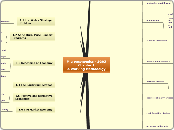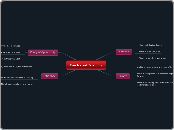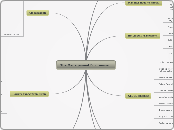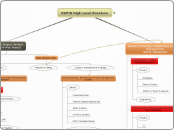Microeconomics - 2G03Chapter 1A Working Methodolgy
Summary
two normative criteria to compare social states
ask wether net social cost is positive or negative
pereto optimal if you can make no one better off
also known as efficiency
pereto preferred if you can make one person better off without making anyone worse off
also known as superior
preferences play a crucial role in economy theory
play a role in normative economics
introduces concepts of
better then
in well being
worse then
play a role in positive economics
based on the theory of self interest choice making
shows how it will be
only instituions are changeable in an economy not the the other three blocks
assumption of chaning institutions is based on
pure-maket (free enterprise) economy
economies are studied in segments through models by use of METHOD OF EQUILIBRIUM
equilibrium is a social state whereno one can make themselves better
Four building blocks of an economy
its institutions
preferences of individuals
resource endownment
Figures
1.5
The circular-flow diagram of an economy
they meet in goods markets and resource markets
firms
supply goods to individuals
Demand resources from individuals
individuals
demand goods from firms
supply resources to firms
1.4
Price Support Programs
1.3
Competitive equilibrium
In a competitive equilibrium, price is such thatquantity demanded equals quantity supplied
1.2
Demand and Supply
the market demand curve D specifies the quantityof butter demanded at any given price, and the marketsupply curve SS specifies the quantity of butter suppliedat any given price
1.1
Attainable water-use profiles
The balanced water-use profile at B (which uses the sameamount of water) is unattainable under the non metered waterscheme
hense the equilibrium for the representive housholderunder the non-metered schem is the unbalanced water-use profile at U.
under the non metered scheme, the house holdercan atain any water-use prifile on line DCU, andhe or she choose the unbalanced water profile.
1.6 The Market Economy
Circular Flow of Economic Activity
1.5 Positive and Normative Economics
Cost - Benefit Analysis
The Pareto Criterion
1.4 The Equilibrium Method
1.3 Describing an Economy
Institutions
Self-Interest and Making Choices
Preferences of Individuals
A Technology
A Resource Endowment
1.2 Agricultural Price Support Programs
Price Supports
Competive Equilibrium Price and Quantity
1.1 The Water Shortage Problem
Common Property Problems
Key Terms
pure-market economy
a theoretical model in which the onlyrelulatory insitutions of economic activityare institutions of private property
net social benefit
the result of subtracting the gross social costfrom the gross social benefit in a cost-benefitanalysis
gross social cost
the total of measure of all individuals' costsin a cost-benefit analysis
gross social benefit
the total of the measure of all individuals'benefit in a cost-benefit analysis
cost-benefit criterion
an allocation that incorporates tradeoffs betweenmaking some individual worse off and making otherindividuals better off
pareto optimalty efficiency
an allocation where no rearrangementcan make someone better off without makingsomeone else worse off
Pareto criterion
if one person is better off in social state A comparedto social state B, and no one is worse off, then by thePareto criterion, we would say state A is better
Normative economics
normative economics attempts to judgebetween social states
the subjective study of economic issues
Positive Economics
attempts to predict or explain social states
the objective study of economic issues.
equilibrium
a set of choices for the individual and acorresponding special state such that noindividual can make himself better off bymaking some other choices
method of equilibirum
The Specific method used by an economist to predictthe social state that will arise from the choices of the individual economic participants
social state
the outcome in a given economy
institutions
a broad category of rules, laws, customs, andorginizations that either substitute or complementexchange and production
theory of self-interest
the idea that all behaviour is motivated to improvethe welfare of the decision maker
The fundamental assumption in economics
preference ordering
a ranking of all possible bundles
preferences
preferences are represented by a utility function
individual tastes that influence the choices of goods chosen
technology
the tools used to convert inputs into outputs
resource endowment
the list of inputs an individual, firm, or economyhas to begin with
economy
a metaphor for the place in which all exchangeand the production takes place
economics
commonly held to be the study of allocatingscarce goods among competing ends
the study of human behaviour using theprinciples of economics
resources
inputs used in the production of goods
goods
short of goods and services
competitive equilibrium price
an allocation where the quantitydemanded equals teh quantity supplied
market supply
it gives the total quantity supplied for a givenprice
the horizantal summation of the individualfirm supply curves.
market demand
it gives the total quantity demanded for a given price
the horizantal summation of individual demands
perfectly competive markets
markets characterized by
and an equilibrium where the quantitydemanded equals the quantity supplied
free exit and entry of firms
many consumers
many firms
unitization
the practice of manaing a pool of oilthat may span accross many privatetracts of land as a single unit
rule of capture
the legal doctrine whereby ownership is establishedby the first person who captures or otherwise occupiesa resource
common property
This creates a problem from over explotingingof the resource.
a situation where the individual or groupof resource owners do not have the rightto exclude others from using the resource
fish in water
trees
oil underneath
water









